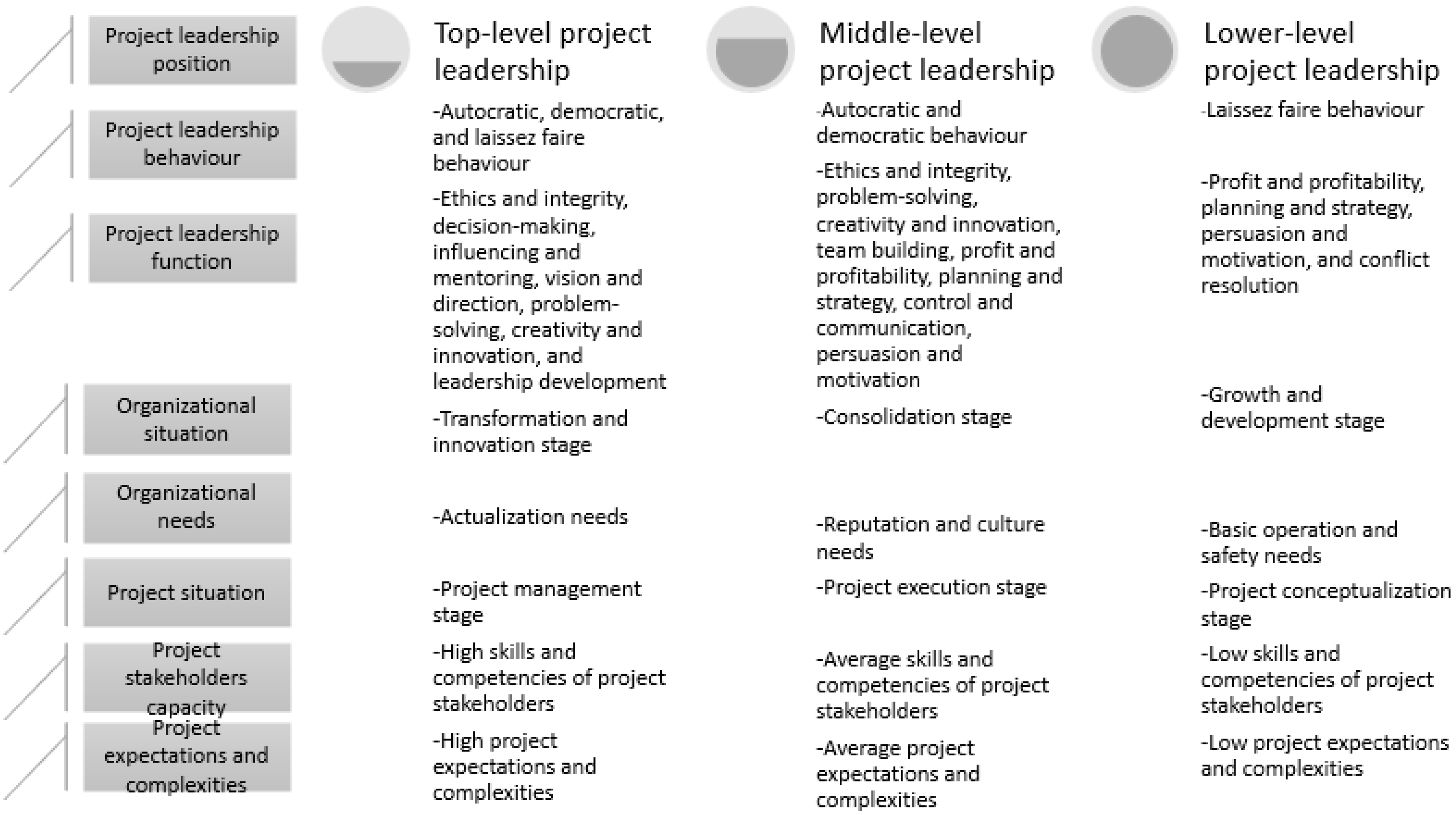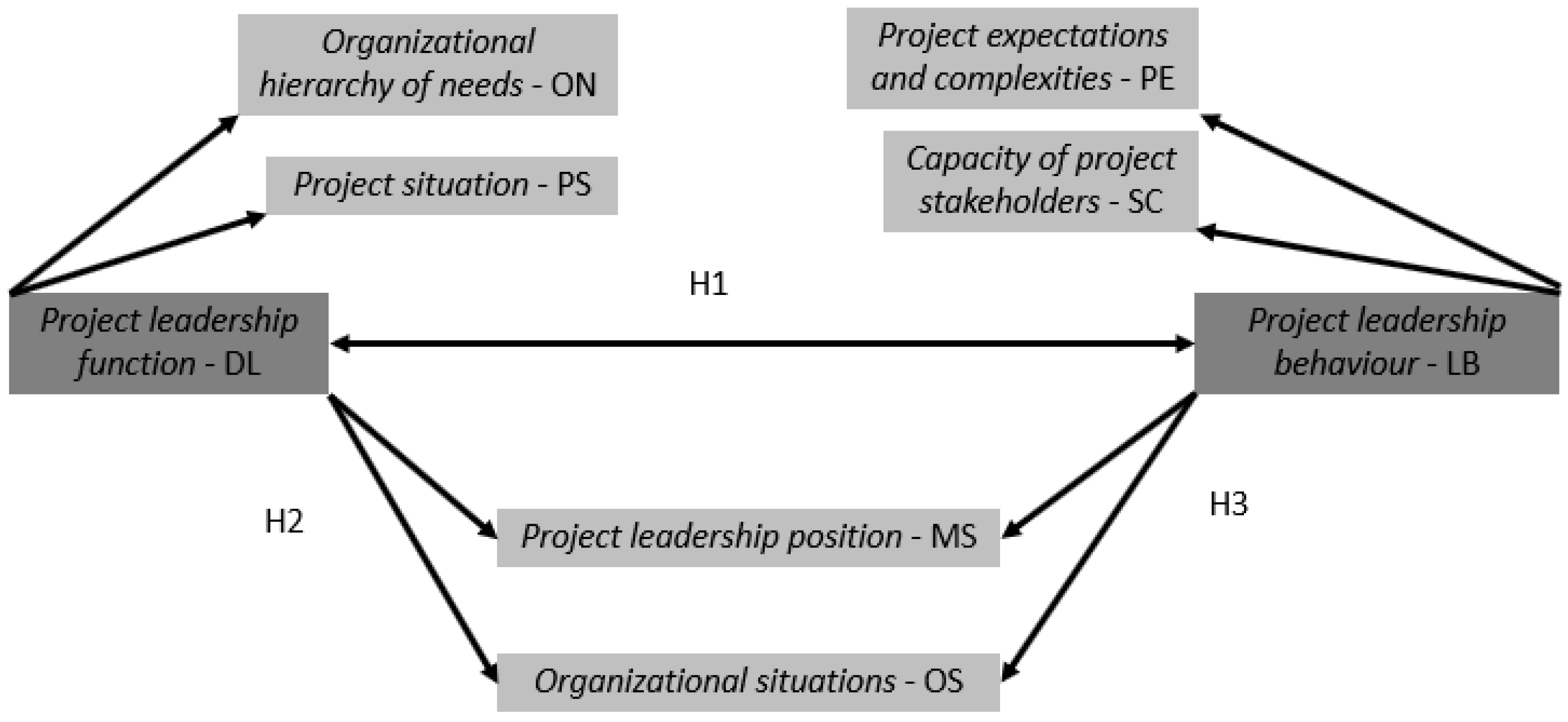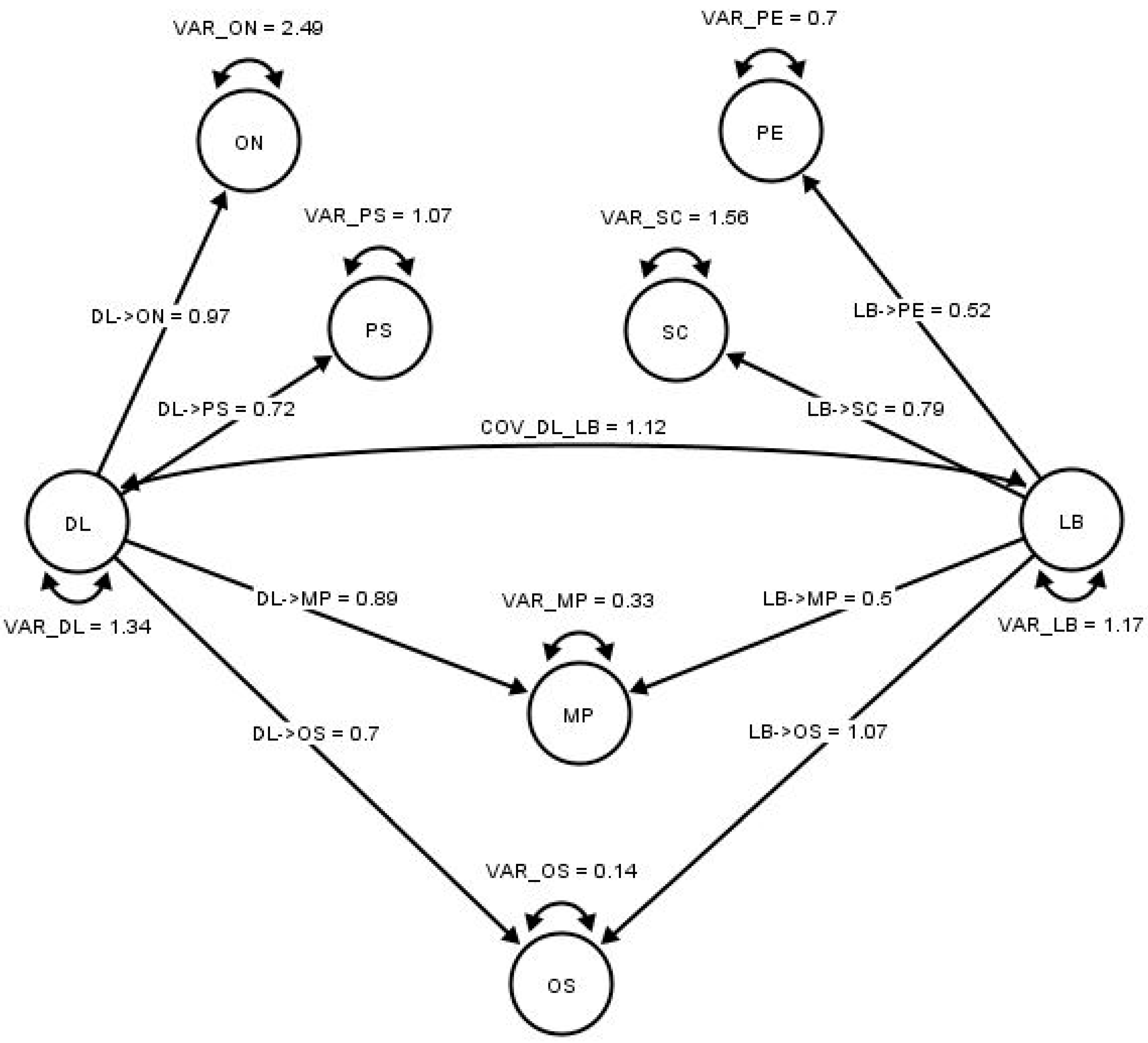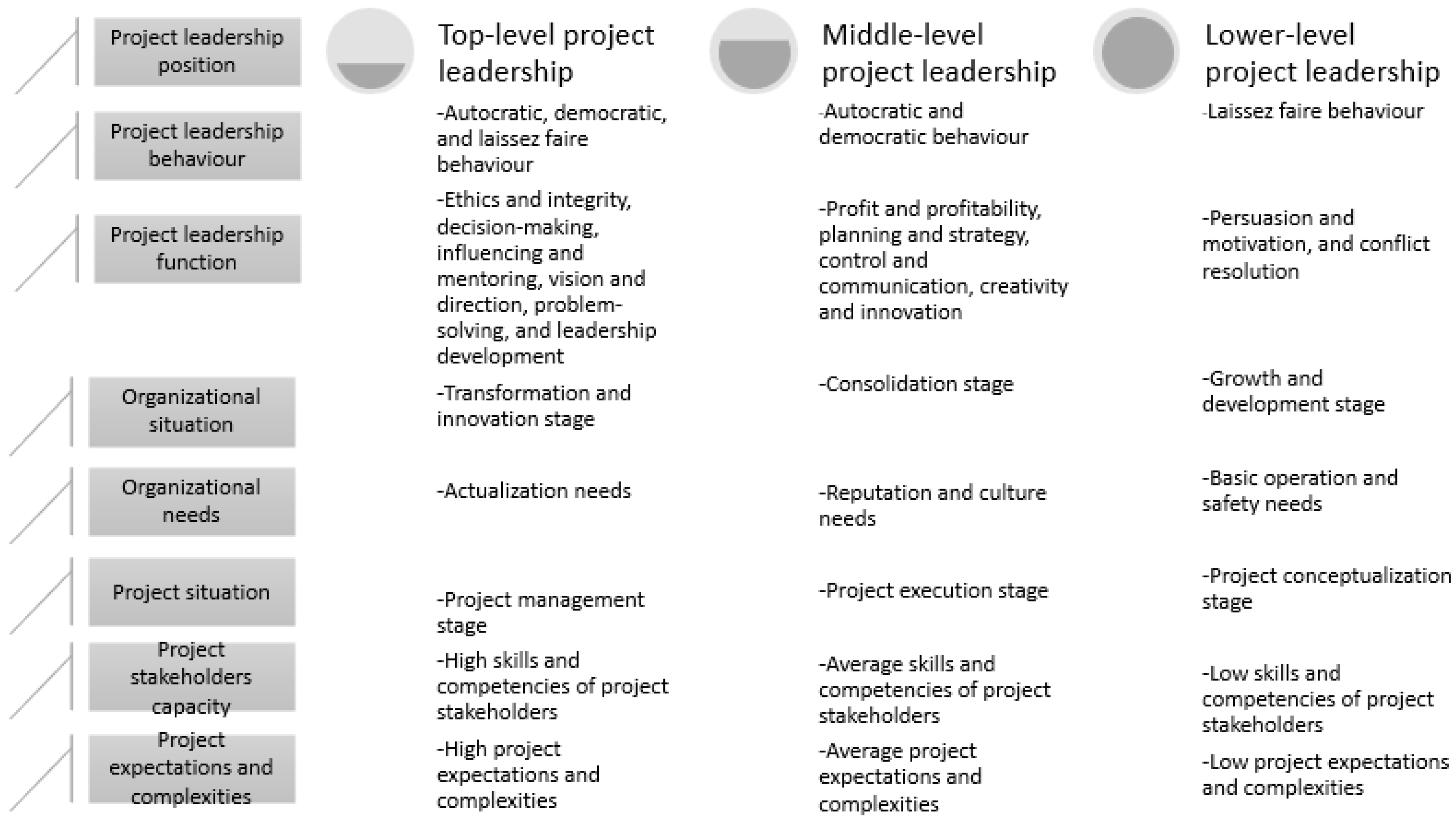Project Leadership Functions and the Associated Behaviour for Projects and Project Organisations
Abstract
1. Introduction
2. Literature Review
2.1. Project Leadership Functions
2.2. Project Leadership Behaviours
2.3. Interrelationships between Project Leadership Functions and Behaviours—The Development of the Project Leadership Model
- Leaders’ development and abilities to master leadership behaviour evolve as they advance up the leadership ladder [55]. As a result, top project leaders must perform at the highest level of leadership function because leadership experience and the lessons learned from that experience are the most potent forces for leadership development [58]. Furthermore, the highest leadership efficacy and responsibility levels can only be found at the top, where the most power and authority reside [53]. To summarise, project leadership and project leaders’ positions overlap. The level of leadership functions at each level determines the degree of overlap.
- Leadership is a broad term that encompasses positions, authority, and responsibilities. This means that leadership is a position as well as a responsibility [16]. It also implies that the leadership function is concerned with the structure and distribution of power, authority, and responsibilities. In contrast, leadership behaviour is concerned with the manner in which power and authority are used [57].
- Different project and organisational situations necessitate varying degrees of leadership function (varying degrees of power, authority, responsibility, and efficacy) [59]. Organisations have a hierarchy of needs that necessitate varying degrees of leadership [55]. Similarly, projects require varying degrees of leadership function based on complexity, expectations, and stakeholder capacity [59,60].
- There is no optimal leadership style for project leaders. Project leaders must be able to use all of the leadership behaviours in order to select the best ones for various positions, projects, and organisational situations [58].
- Top project leaders are the most valuable assets of organisations and projects [61]. As a result, they must participate in a company’s direction, strategy, high-level leadership, effectiveness, and philosophy, characterize the organisation’s vision, establish common organisational values and concepts, capitalize on opportunities, promote innovation, evaluate risk, and lead the organisation in achieving its organisational objectives [57]. Similarly, their leadership functions are critical to project success as well as the formation of organisational culture and values [61].
3. Research Methods
4. Results
4.1. Project Leadership Functions
4.2. Project Leadership Behaviours
4.3. Testing the Project Leadership Model
5. Discussion of Findings
5.1. Project Leadership Function
5.2. Project Leadership Behaviour
5.3. Project Leadership Model
5.4. Practical Implications
5.5. Research Implications
5.6. Limitations and Future Studies
6. Conclusions
Author Contributions
Funding
Data Availability Statement
Conflicts of Interest
References
- Floris, M.; Cuganesan, S. Project leaders in transition: Manifestations of cognitive and emotional capacity. Int. J. Proj. Manag. 2019, 37, 517–532. [Google Scholar] [CrossRef]
- Liphadzi, M.; Aigbavboa, C.; Thwala, W. Relationship between leadership styles and project success in the South Africa construction industry. Procedia Eng. 2015, 123, 284–290. [Google Scholar] [CrossRef]
- Muriithi, N.; Crawford, L. Approaches to project management in Africa: Implications for international development projects. Int. J. Proj. Manag. 2003, 21, 309–319. [Google Scholar] [CrossRef]
- Krog, C.L.; Govender, K. The relationship between servant leadership and employee empowerment, commitment, trust and innovative behaviour: A project management perspective. SA J. Hum. Resour. Manag. 2015, 13, 1–12. [Google Scholar] [CrossRef]
- Ahmed, R.; Azmi, N.; Masood, M.T.; Tahir, M.; Ahmad, M.S. What does project leadership really do? Int. J. Sci. Eng. Res. 2013, 4, 1–8. [Google Scholar]
- Littrell, R.F. Contemporary Sub-Saharan African managerial leadership research: Some recent empirical studies. Asia Pac. J. Bus. Manag. 2011, 2, 65–91. [Google Scholar]
- Littrell, R.F.; Wu, N.H.; Nkomo, S. Pan-Sub-Saharan African managerial leadership and the values of Ubuntu. In Management in Africa; Routledge: Oxfordshire, UK, 2013; pp. 252–268. [Google Scholar]
- Bilal, A.; Siddiquei, A.; Asadullah, M.A.; Awan, H.M.; Asmi, F. Servant leadership: A new perspective to explore project leadership and team effectiveness. Int. J. Organ. Anal. 2021, 29, 699–715. [Google Scholar] [CrossRef]
- Thoha, N.; Avandana, I.M.N.W. Project Managers’ Leadership Styles and Their Effects on Project Management Performance. Pertanika J. Soc. Sci. Humanit. 2020, 14, 3–10. [Google Scholar]
- Alblooshi, M.; Shamsuzzaman, M.; Haridy, S. The relationship between leadership styles and organizational innovation: A systematic literature review and narrative synthesis. Eur. J. Innov. Manag. 2021, 24, 338–370. [Google Scholar] [CrossRef]
- Jelača, M.S.; Milićević, N.; Bjekić, R.; Petrov, V. The effects of environmental uncertainty and leadership styles on organizational innovativeness. Eng. Econ. Inžinerinė Ekon. 2020, 31, 472–486. [Google Scholar] [CrossRef]
- Zia, N.U. Knowledge-oriented leadership, knowledge management behaviour and innovation performance in project-based SMEs. The moderating role of goal orientations. J. Knowl. Manag. 2020, 24, 1819–1839. [Google Scholar] [CrossRef]
- Tran, Q.H. Organizational culture, leadership behaviour and job satisfaction in the Vietnam context. Int. J. Organ. Anal. 2021, 29, 136–154. [Google Scholar] [CrossRef]
- Aitken, K.; Von Treuer, K. Leadership behaviours that foster organizational identification during change. J. Organ. Chang. Manag. 2021, 34, 311–326. [Google Scholar] [CrossRef]
- Wuryani, E.; Rodlib, A.; Sutarsib, S.; Dewib, N.; Arifb, D. Analysis of decision support system on situational leadership styles on work motivation and employee performance. Manag. Sci. Lett. 2021, 11, 365–372. [Google Scholar] [CrossRef]
- Ali, A.; Wang, H.; Boekhorst, J.A. A moderated mediation examination of shared leadership and team creativity: A social information processing perspective. Asia Pac. J. Manag. 2023, 40, 295–327. [Google Scholar] [CrossRef]
- Bukoye, T.; Ejohwomu, O.; Jens, R.; Too, J. Using nudges to realise project performance. Int. J. Proj. Manag. 2022, 40, 886–905. [Google Scholar] [CrossRef]
- Holzmann, V.; Mazzini, L. Applying Project Management to Creative Industries: The Relationship Between Leadership Style and Project Success. J. Organ. Cult. Commun. Confl. 2020, 24, 1–17. [Google Scholar]
- Zaman, U. Examining the effect of xenophobia on “transnational” mega construction project (MCP) success: Moderating role of transformational leadership and high-performance work (HPW) practices. Eng. Constr. Archit. Manag. 2020, 27, 1119–1143. [Google Scholar] [CrossRef]
- Zaman, U.; Florez-Perez, L.; Khwaja, M.G.; Abbasi, S.; Qureshi, M.G. Exploring the critical nexus between authoritarian leadership, project team member’s silence and multi-dimensional success in a state-owned mega construction project. Int. J. Proj. Manag. 2021, 39, 873–886. [Google Scholar] [CrossRef]
- Fard, H.D.; Hajiani, M.; Fatemifar, K.; Khabbaz, M.G. Leadership in project management: A scoping review. Int. J. Proj. Organ. Manag. 2020, 12, 74–116. [Google Scholar] [CrossRef]
- Rehman, S.U.; Shahzad, M.; Farooq, M.S.; Javaid, M.U. Impact of leadership behaviour of a project manager on his/her subordinate’s job attitudes and job outcomes. Asia Pac. Manag. Rev. 2020, 25, 38–47. [Google Scholar]
- Skeepers, N.C.; Mbohwa, C. A study on the leadership behaviour, safety leadership and safety performance in the construction industry in South Africa. Procedia Manuf. 2015, 4, 10–16. [Google Scholar] [CrossRef]
- Owusu-Manu, D.G.; Debrah, C.; Amissah, L.; Edwards, D.J.; Chileshe, N. Exploring the linkages between project managers’ mindset behaviour and project leadership style in the Ghanaian construction industry. Eng. Constr. Archit. Manag. 2020, 28, 2690–2711. [Google Scholar] [CrossRef]
- Khan, N.A.; Khan, A.N.; Soomro, M.A.; Khan, S.K. Transformational leadership and civic virtue behaviour: Valuing act of thriving and emotional exhaustion in the hotel industry. Asia Pac. Manag. Rev. 2020, 25, 216–225. [Google Scholar]
- Puni, A.; Agyemang, C.B.; Asamoah, E.S. Leadership styles, employee turnover intentions and counterproductive work behaviours. Int. J. Innov. Res. Dev. 2016, 5, 1–7. [Google Scholar]
- Muganda, O.N.; Kandiri, J.; Johnson, R. Influence processes of implementation effectiveness in challenged information technology projects in Africa. Inf. Technol. People 2014, 27, 318–340. [Google Scholar] [CrossRef]
- Muganda, N.; Pillay, K. Forms of power, politics and leadership in asynchronous virtual project environment: An exploratory analysis in South Africa. Int. J. Manag. Proj. Bus. 2013, 6, 457–484. [Google Scholar] [CrossRef]
- Gemünden, H.G.; Lehner, P.; Kock, A. The project-oriented organization and its contribution to innovation. Int. J. Proj. Manag. 2018, 36, 147–160. [Google Scholar] [CrossRef]
- Lindgren, M.; Packendorff, J. Project leadership revisited: Towards distributed leadership perspectives in project research. Int. J. Proj. Organ. Manag. 2009, 1, 285–308. [Google Scholar] [CrossRef]
- Buba, S.P.G.; Tanko, B.L. Project leadership and quality performance of construction projects. Int. J. Built Environ. Sustain. 2017, 4. [Google Scholar] [CrossRef]
- Buba, S.P.G.; Chitumu, D.Z.; Ibrahim, H.M. Project leadership and its impact on-time performance in Nigerian construction projects. Adv. Sci. Lett. 2018, 24, 3791–3796. [Google Scholar] [CrossRef]
- Jung, Y.; Jeong, M.G.; Mills, T. Identifying the preferred leadership style for the managerial position of construction management. Int. J. Constr. Eng. Manag. 2014, 3, 47–56. [Google Scholar] [CrossRef]
- Zulch, B. Leadership communication in project management. Procedia-Soc. Behav. Sci. 2014, 119, 172–181. [Google Scholar] [CrossRef]
- Thite, M. Leadership styles in information technology projects. Int. J. Proj. Manag. 2000, 18, 235–241. [Google Scholar] [CrossRef]
- Pretorius, S.; Steyn, H.; Bond-Barnard, T.J. Leadership styles in projects: Current trends and future opportunities. S. Afr. J. Ind. Eng. 2018, 29, 161–172. [Google Scholar] [CrossRef]
- Vuorinen, L.; Martinsuo, M. Value-oriented stakeholder influence on infrastructure projects. Int. J. Proj. Manag. 2019, 37, 750–766. [Google Scholar] [CrossRef]
- de Oliveira, G.F.; Rabechini, R., Jr. Stakeholder management influence on trust in a project: A quantitative study. Int. J. Proj. Manag. 2019, 37, 131–144. [Google Scholar] [CrossRef]
- Gehring, D.R. Applying traits theory of leadership to project management. Proj. Manag. J. 2007, 38, 44–54. [Google Scholar] [CrossRef]
- Prabhakar, G.P. Switch leadership in projects an empirical study reflecting the importance of transformational leadership on project success across twenty-eight nations. Proj. Manag. J. 2005, 36, 53–60. [Google Scholar] [CrossRef]
- Thite, M. Identifying key characteristics of technical project leadership. Leadersh. Organ. Dev. J. 1999, 20, 253–261. [Google Scholar] [CrossRef]
- Ahmed, R.; Tahir, M.; Azmi bin Mohamad, N. Leadership is vital for project managers to achieve project efficacy. Res. J. Recent Sci. 2013, 2, 99–102. [Google Scholar]
- Busari, A.H.; Khan, S.N.; Abdullah, S.M.; Mughal, Y.H. Transformational leadership style, followership, and factors of employees’ reactions towards organizational change. J. Asia Bus. Stud. 2020, 14, 181–209. [Google Scholar] [CrossRef]
- Nkomo, S.M. A postcolonial and anti-colonial reading of ‘African leadership and management in organization studies: Tensions, contradictions and possibilities. Organization 2011, 18, 365–386. [Google Scholar] [CrossRef]
- Nkomo, S.M.; Ngambi, H. African women in leadership: Current knowledge and a framework for future studies. Int. J. Afr. Renaiss. Stud. 2009, 4, 49–68. [Google Scholar] [CrossRef]
- Demircioglu, M.A.; Chowdhury, F. Entrepreneurship in public organizations: The role of leadership behaviour. Small Bus. Econ. 2021, 57, 1107–1123. [Google Scholar] [CrossRef]
- Sobratee, N.; Bodhanya, S. Leading in a global context: The balancing act between leadership and management. J. Bus. Retail. Manag. Res. 2018, 12, 54–69. [Google Scholar] [CrossRef]
- Wanasika, I.; Howell, J.P.; Littrell, R.; Dorfman, P. Managerial leadership and culture in Sub-Saharan Africa. J. World Bus. 2011, 46, 234–241. [Google Scholar] [CrossRef]
- Wilson, S.; Lee, H.; Ford, J.; Harding, N. On the ethics of psychometric instruments used in leadership development programmes. J. Bus. Ethics 2021, 172, 211–227. [Google Scholar] [CrossRef]
- Witton, F.; Rasheed, E.O.; Rotimi, J.O.B. Does leadership style differ between a post-disaster and non-disaster response project? A study of three major projects in New Zealand. Buildings 2019, 9, 195. [Google Scholar] [CrossRef]
- Buch, R.; Martinsen, Ø.L.; Kuvaas, B. The destructiveness of laissez-faire leadership behaviour: The mediating role of economic leader–member exchange relationships. J. Leadersh. Organ. Stud. 2015, 22, 115–124. [Google Scholar] [CrossRef]
- Francisco, C.D.; Nuqui, A.V. Emergence of a Situational Leadership during COVID-19 Pandemic Called New Normal Leadership. Online Submiss. 2020, 4, 15–19. [Google Scholar]
- Naderpajouh, N.; Matinheikki, J.; Keeys, L.A.; Aldrich, D.P.; Linkov, I. Resilience and projects: An interdisciplinary crossroad. Proj. Leadersh. Soc. 2020, 1, 100001. [Google Scholar] [CrossRef]
- Al Khajeh, E.H. Impact of leadership styles on organizational performance. J. Hum. Resour. Manag. Res. 2018, 2018, 687849. [Google Scholar] [CrossRef]
- Ceri-Booms, M.; Curşeu, P.L.; Oerlemans, L.A. Task and person-focused leadership behaviours and team performance: A meta-analysis. Hum. Resour. Manag. Rev. 2017, 27, 178–192. [Google Scholar]
- Schoemaker, P.J.; Heaton, S.; Teece, D. Innovation, dynamic capabilities, and leadership. Calif. Manag. Rev. 2018, 61, 15–42. [Google Scholar] [CrossRef]
- Cilek, A. The effect of leadership on organizational commitment: A meta-analysis. Cypriot J. Educ. Sci. 2019, 14, 554–564. [Google Scholar] [CrossRef]
- Engelbrecht, A.; Samuel, O.M. The effect of transformational leadership on intention to quit through perceived organizational support, organizational justice and trust. S. Afr. J. Econ. Manag. Sci. 2019, 22, 1–8. [Google Scholar] [CrossRef]
- Singh, S.K.; Gupta, S.; Busso, D.; Kamboj, S. Top management knowledge value, knowledge sharing practices, open innovation and organizational performance. J. Bus. Res. 2021, 128, 788–798. [Google Scholar] [CrossRef]
- Meng, J.; Berger, B.K. The impact of organizational culture and leadership performance on PR professionals’ job satisfaction: Testing the joint mediating effects of engagement and trust. Public Relat. Rev. 2019, 45, 64–75. [Google Scholar] [CrossRef]
- Ibrahim, A.U.; Daniel, C.O. Impact of leadership on organizational performance. Int. J. Bus. Manag. Soc. Res. 2019, 6, 367–374. [Google Scholar] [CrossRef]
- Wolf, E.J.; Harrington, K.M.; Clark, S.L.; Miller, M.W. Sample size requirements for structural equation models an evaluation of power, bias, and solution propriety. Educ. Psychol. Meas. 2013, 73, 913–934. [Google Scholar] [CrossRef]
- Taherdoost, H. What is the best response scale for survey and questionnaire design; review of different lengths of rating scale/attitude scale/Likert scale. Hamed Taherdoost 2019, 8, 1–10. [Google Scholar]
- Jacoby, J.; Matell, M.S. Three-Point Likert Scales Are Good Enough. J. Mark. Res. 1971, 8, 495–500. [Google Scholar] [CrossRef]
- Olugboyega, O.; Windapo, A. Modelling the indicators of a reduction in BIM adoption barriers in a developing country. Int. J. Constr. Manag. 2023, 23, 1581–1591. [Google Scholar] [CrossRef]
- Rogito, J.M.; Nyamota, G. Cross-cultural differences in leadership and management of agricultural projects in Africa. J. Innov. Sustain. 2022, 6, 1. [Google Scholar] [CrossRef]




| Profile | Percent |
|---|---|
| Minimum educational qualification of the project leaders: | |
| BSc | 18.69% |
| MSc | 66.82% |
| PhD | 14.48% |
| Project leadership level: | |
| Top-level | 10.28% |
| Middle level | 48.59% |
| Lower level | 41.12% |
| Project leadership positions on projects: | |
| Project leadership | 1.40% |
| Construction leadership | 11.21% |
| Site supervision and leadership | 15.42% |
| Safety leadership | 6.54% |
| Quality control and leadership | 5.60% |
| Schedule and time leadership | 4.67% |
| Procurement control and leadership | 11.21% |
| Stakeholder management | 3.73% |
| Contract administration | 13.08% |
| Conflict resolution | 1.86% |
| Human Resources management | 5.14% |
| Cost control | 7.00% |
| Level of project leadership experience from the project executed: | |
| High | 14.48% |
| Middle | 64.01% |
| Low | 21.49% |
| Level of power and authority on the project executed: | |
| High | 13.08% |
| Middle | 65.88% |
| Low | 21.02% |
| Gender: | |
| Male | 76.63% |
| Female | 23.36% |
| Project Leadership Functions | Project Leadership Positions | Project Situations | Organisational Situations | Organisational Needs | Project Leadership Behaviour |
|---|---|---|---|---|---|
| Ethics and integrity | 4.21 Top-level leadership | 3.97 Concept stage | 4.41 Growth and development stage | 4.58 Culture and reputation | 3.67 Autocratic |
| Team building | 3.95 Middle-level leadership | 4.40 Concept stage | 4.01 Transformation and innovation stage | 4.40 Vision actualisation | 3.66 Democratic |
| Profit and profitability | 3.68 Middle-level leadership | 3.84 Project management stage | 4.01 Growth and development stage | 4.34 Basic operation and safety | 4.01 Autocratic |
| Decision making | 3.76 Top-level leadership | 3.74 Execution stage | 3.66 Transformation and innovation stage | 4.08 Vision actualisation | 4.45 Democratic |
| Planning and strategy | 3.87 Middle-level leadership | 4.41 Concept stage | 3.71 Growth and development stage | 4.16 Vision actualisation | 4.22 Democratic |
| Control, communication, and command | 4.03 Middle-level leadership | 4.01 Execution stage | 3.65 Consolidation stage | 3.94 Basic operation and safety | 4.37 Autocratic |
| Influencing and mentoring | 4.04 Top-level leadership | 3.88 Execution stage | 3.66 Transformation and innovation stage | 3.68 Culture and reputation | 3.94 Democratic |
| Persuasion and motivation | 3.88 Lower-level leadership | 3.75 Execution stage | 4.44 Transformation and innovation stage | 3.77 Vision actualisation | 3.84 Democratic |
| Vision and direction | 3.68 Top-level leadership | 3.68 Concept stage | 4.04 Transformation and innovation stage | 3.64 Vision actualisation | 4.12 Autocratic |
| Conflict resolution | 4.22 Lower-level leadership | 3.66 Execution stage | 3.81 Transformation and innovation stage | 3.88 Basic operation and safety | 3.65 Democratic |
| Problem-solving | 3.68 Top-level leadership | 3.61 Execution stage | 3.65 Transformation and innovation stage | 3.73 Basic operation and safety | 3.65 Democratic |
| Creativity and innovation | 4.01 Middle-level leadership | 4.01 Concept stage | 4.22 Transformation and innovation stage | 4.43 Vision actualisation | 4.23 Democratic |
| Leadership development | 4.42 Top-level leadership | 4.04 Execution stage | 4.34 Growth and development stage | 3.66 Culture and reputation | 3.62 Laissez-faire |
| Project Leadership Behaviour | Project Expectations and Complexity | The Capacity of Project Stakeholders | Organisational Situations |
|---|---|---|---|
| Autocratic behaviour | 4.44 High expectations | 4.56 Low capacity | 4.40 Growth and development stage |
| Democratic behaviour | 3.65 Average expectations | 4.55 Average capacity | 3.78 Consolidation stage |
| Laissez-faire behaviour | 4.01 Low expectations | 4.02 High Capacity | 3.66 Transformation and innovation stage |
| Relationships | The Magnitude of Relationship (r) | Standard Error | Significance of Relationship (z) |
|---|---|---|---|
| LB->OS | 1.073857500113927 | 0.09736576043724104 | 11.029108130944064 |
| DL->MP | 0.8077398441270782 | 0.07755862576565797 | 10.414571379431734 |
| DL->OS | 0.69429340479779 | 0.06780543600955237 | 10.239494731661022 |
| LB->MP | 0.5033837029537329 | 0.052076072425521855 | 9.666314672130124 |
| COV_DL_LB | 1.1173371222484454 | 0.10420739576699692 | 10.722243983015959 |
| DL->ON | 0.9651354445830407 | 0.0891886947977365 | 10.821275575024275 |
| DL->PS | 0.7200255103951971 | 0.06949271720268724 | 10.361165016689752 |
| LB->PE | 0.5182034577476311 | 0.05149132816611202 | 10.063897673718897 |
| LB->SC | 0.7874384143877303 | 0.07355985609893684 | 10.704730217642599 |
Disclaimer/Publisher’s Note: The statements, opinions and data contained in all publications are solely those of the individual author(s) and contributor(s) and not of MDPI and/or the editor(s). MDPI and/or the editor(s) disclaim responsibility for any injury to people or property resulting from any ideas, methods, instructions or products referred to in the content. |
© 2023 by the authors. Licensee MDPI, Basel, Switzerland. This article is an open access article distributed under the terms and conditions of the Creative Commons Attribution (CC BY) license (https://creativecommons.org/licenses/by/4.0/).
Share and Cite
Olugboyega, O.; Ejohwomu, O.; Omopariola, E.D.; Omoregie, A. Project Leadership Functions and the Associated Behaviour for Projects and Project Organisations. Buildings 2023, 13, 1739. https://doi.org/10.3390/buildings13071739
Olugboyega O, Ejohwomu O, Omopariola ED, Omoregie A. Project Leadership Functions and the Associated Behaviour for Projects and Project Organisations. Buildings. 2023; 13(7):1739. https://doi.org/10.3390/buildings13071739
Chicago/Turabian StyleOlugboyega, Oluseye, Obuks Ejohwomu, Emmanuel Dele Omopariola, and Alohan Omoregie. 2023. "Project Leadership Functions and the Associated Behaviour for Projects and Project Organisations" Buildings 13, no. 7: 1739. https://doi.org/10.3390/buildings13071739
APA StyleOlugboyega, O., Ejohwomu, O., Omopariola, E. D., & Omoregie, A. (2023). Project Leadership Functions and the Associated Behaviour for Projects and Project Organisations. Buildings, 13(7), 1739. https://doi.org/10.3390/buildings13071739







